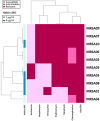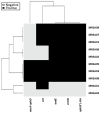In Vivo Effect of Halicin on Methicillin-Resistant Staphylococcus aureus-Infected Caenorhabditis elegans and Its Clinical Potential
- PMID: 39335079
- PMCID: PMC11429483
- DOI: 10.3390/antibiotics13090906
In Vivo Effect of Halicin on Methicillin-Resistant Staphylococcus aureus-Infected Caenorhabditis elegans and Its Clinical Potential
Abstract
Recently, the high proportion of methicillin-resistant Staphylococcus aureus infections worldwide has highlighted the urgent need for novel antibiotics to combat this crisis. The recent progress in computational techniques for use in health and medicine, especially artificial intelligence (AI), has created new and potential approaches to combat antibiotic-resistant bacteria, such as repurposing existing drugs, optimizing current agents, and designing novel compounds. Halicin was previously used as a diabetic medication, acting as a c-Jun N-terminal protein kinase (JNK) inhibitor, and has recently demonstrated unexpected antibacterial activity. Although previous efforts have highlighted halicin's potential as a promising antibiotic, evidence regarding its effectiveness against clinical strains remains limited, with insufficient proof of its clinical applicability. In this study, we sought to investigate the antibacterial activity of halicin against MRSA clinical strains to validate its clinical applicability, and a C. elegans model infected by MRSA was employed to evaluate the in vivo effect of halicin against MRSA. Our findings revealed the antibacterial activity of halicin against methicillin-resistant S. aureus clinical strains with MICs ranging from 2 to 4 µg/mL. Our study is also the first work to evaluate the in vivo effect of halicin against S. aureus using a C. elegans model, supporting its further development as an antibiotic.
Keywords: Caenorhabditis elegans; halicin; in vivo evaluation; methicillin-resistant Staphylococcus aureus.
Conflict of interest statement
The authors declare no conflicts of interest.
Figures



Similar articles
-
Halicin Is Effective Against Staphylococcus aureus Biofilms In Vitro.Clin Orthop Relat Res. 2022 Aug 1;480(8):1476-1487. doi: 10.1097/CORR.0000000000002251. Epub 2022 May 17. Clin Orthop Relat Res. 2022. PMID: 35583504 Free PMC article.
-
Halicin: A New Horizon in Antibacterial Therapy against Veterinary Pathogens.Antibiotics (Basel). 2024 May 27;13(6):492. doi: 10.3390/antibiotics13060492. Antibiotics (Basel). 2024. PMID: 38927159 Free PMC article.
-
Assessment of the Antibacterial Efficacy of Halicin against Pathogenic Bacteria.Antibiotics (Basel). 2021 Dec 2;10(12):1480. doi: 10.3390/antibiotics10121480. Antibiotics (Basel). 2021. PMID: 34943692 Free PMC article.
-
Anti-MRSA agent discovery using Caenorhabditis elegans-based high-throughput screening.J Microbiol. 2020 Jun;58(6):431-444. doi: 10.1007/s12275-020-0163-8. Epub 2020 May 27. J Microbiol. 2020. PMID: 32462486 Review.
-
Lactic acid bacteria and their bacteriocins: new potential weapons in the fight against methicillin-resistant Staphylococcus aureus.Future Microbiol. 2022 Jun;17:683-699. doi: 10.2217/fmb-2021-0256. Epub 2022 Apr 13. Future Microbiol. 2022. PMID: 35414206 Review.
Cited by
-
Utility of Artificial Intelligence in Antibiotic Development: Accelerating Discovery in the Age of Resistance.Cureus. 2025 Jan 31;17(1):e78296. doi: 10.7759/cureus.78296. eCollection 2025 Jan. Cureus. 2025. PMID: 40027042 Free PMC article. Review.
References
-
- Foster T.J. Staphylococcus aureus. Mol. Med. Microbiol. 2002;2:839–888.
-
- Taylor T.A., Unakal C.G. StatPearls. Ineligible Companies; Treasure Island, FL, USA: 2024. Staphylococcus aureus Infection. - PubMed
-
- David M.Z., Daum R.S. Treatment of Staphylococcus aureus infections. Curr. Top Microbiol. Immunol. 2017;409:325–383. - PubMed
Grants and funding
- 112-2320-B-037-033, 112-2320-B-214-009, 113-2327-B-037-001, and 113-2320-B-715-004/National Science and Technology Council
- NSYSUKMU 113-P10/National Sun Yat-sen University-Kaohsiung Medical University (NSYSU-KMU) Joint Research Project
- KMU-DK(A)113016/KMU-KMUH Co-Project of Key Research
- NPUST-KMU-109-P003/NPUST-KMU Joint Research Project
- KMU-TC113B01/Kaohsiung Medical University Research Center
LinkOut - more resources
Full Text Sources
Molecular Biology Databases
Research Materials
Miscellaneous

